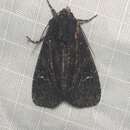Conservation Status
provided by University of Alberta Museums
Local; rare
- license
- cc-by-nc
- copyright
- University of Alberta Museums
Cyclicity
provided by University of Alberta Museums
July.
- license
- cc-by-nc
- copyright
- University of Alberta Museums
Distribution
provided by University of Alberta Museums
ME and NS west across s. Canada to Vancouver Island; south through MT to ?? The plots for SK in Fig. 9344-3 indicate the northernmost records only.
- license
- cc-by-nc
- copyright
- University of Alberta Museums
General Description
provided by University of Alberta Museums
A medium-size (3.5 cm. ws) dark brown-black moth. “General effect blackish, mottled dull wood brown, with heavy black shading, mainly along veins. Ordinary lines obscure, except for double bars at costa; basal dash and dash near base of inner margin black, median dash obsolete; terminal area with fine black streaks on veins and bars between veins, the latter very heavy in fold; orb. thick, oblique, somewhat paler, ren. with whitish bar on outer edge. HW dull luteous and fuscous grey” (Forbes, 1954). Antennae simple; sexes similar. Male genitalia: Costal lobe of valve very large (much larger than in commoda), digitus good-sized but weak
- license
- cc-by-nc
- copyright
- University of Alberta Museums
Habitat
provided by University of Alberta Museums
Meadows and woodland edges.
- license
- cc-by-nc
- copyright
- University of Alberta Museums
Trophic Strategy
provided by University of Alberta Museums
grasses.
- license
- cc-by-nc
- copyright
- University of Alberta Museums
Apamea plutonia: Brief Summary
provided by wikipedia EN
Apamea plutonia, the dusky Quaker or dusky apamea, is a moth of the family Noctuidae. The species was first described by Augustus Radcliffe Grote in 1883. It is native to northern North America, where it occurs across the boreal regions, with some occurrences from as far south as New Mexico and Pennsylvania.
The forewing length is 16 to 17 millimeters, and the wings are very dark brown, nearly black.
The cutworm larva feeds on grasses.
- license
- cc-by-sa-3.0
- copyright
- Wikipedia authors and editors

